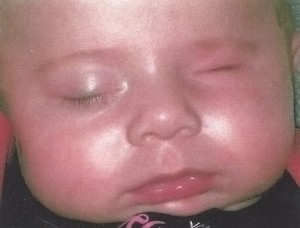Treating Microphthalmia in Babies
 Was your infant born with microphthalmia?
Was your infant born with microphthalmia?
Do you know the best procedure to treat microphthalmia?
Are you searching for the most comfortable prosthetic eye available for your child?
Microphthalmia is a condition in which one or both eyes are abnormally small and have anatomic malformations at birth. It typically results in blindness and affects an estimated 1 in every 10,000 children each year.
While vision can’t be restored, therapy can help increase the size of the eye socket and a special type of prosthetic eye called a corneal scleral shell can create the appearance of a normal, functioning eye. Babies with microphthalmia receive graduated conformer therapy and a prosthetic eye from a ocularist, a medical professional who is specially trained in fitting and crafting prosthetic eyes.
Helping Pediatric Patients and Families Thrive with Personalized Care
“Learning that your baby has impaired or lost eyesight can be difficult for parents,” says Anna Boyd Jefferson, one of two board-certified ocularists with Carolina Eye Prosthetics in Burlington, North Carolina. “We understand that microphthalmia and the process to create a prosthetic eye is unfamiliar and can feel scary, so we like to spend as much time as needed with each family to answer questions, explain options, and create a personal approach that is best for each individual child and family.”
Helping a child have what they need to thrive in society as they grow older is one of the main goals shared by both parents and the team at Carolina Eye Prosthetics. Relationships with children and their families starts at a young age and lasts many years, notes Jefferson, so it’s important to focus on communication and an environment where everyone feels comfortable.
Graduated Conformer Therapy
Graduated conformer therapy helps stretch and manipulate the eye socket tissue to make the affected eye symmetrical with the child’s companion eye and to create space for the prosthetic eye. Infant patients can start graduated conformer therapy as young as one week old. Not all children will need early intervention, as it depends on the size of the microphthalmic eye.
Once the ocularist can achieve enough symmetry through graduated conformer therapy, it’s time to fit the child with their first corneal scleral shell. The shell is a type of prosthetic eye that is thin like a contact lens. The fitting and creation of the scleral shell is an all-day procedure; however, there are breaks throughout the day.
“We understand how to help babies and children feel at ease during the fitting, and our processes are gentle and safe,” says Jefferson.
Creating a Prosthetic Eye
Each prosthetic eye, including the corneal scleral shell used for microphthalmia, is crafted from the finest quality of acrylic plastic (methyl methacrylate resin), the same material used to make dentures since 1939. After the correct size eye is created, the ocularist uses a special painting method to accurately match the companion eye’s color, size, and iris size.
The mother of one pediatric patient recently shared how a prosthetic eye had impacted her daughter who is now 6 years old. “Eleanor feels great and looks great —and most kids don’t even know there’s anything different about her,” says Virginia Wilkins of her daughter. “Carolina Eye Prosthetics has been awesome at making Ellie feel comfortable.”
Eleanor is a curious, vivacious, and very confident girl with an entire lifetime ahead of her. She practices gymnastics and dance, rides a bike, reads, and is a big sister to her little brother Win. Read more about Eleanor’s story.
Schedule a Microphthalmia Consultation Today
The team at Carolina Eye Prosthetics has years of experience providing graduated conformer therapy and customized prosthetic eyes for babies and children with microphthalmia.
Contact us to discuss your child’s specific needs at 1-877-763-9393.
